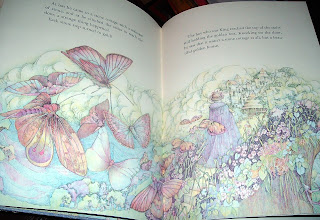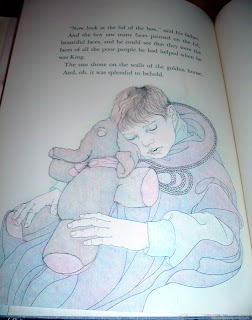Looking through old Bibles can sometimes reveal interesting items that have been tucked away among the leaves for decades or centuries, or one might find traces of provenance through written lines of ownership, along with recorded family history. This First Brookfield Edition was no exception to all of the above. What likely was the exception for this particular Bible was the crafty and inventive repair of a single, torn page with the tools of an amateur book conservator: A needle and thread.

Earlier this year, I acquired this old Bible, the First Brookfield Edition, of The Holy Bible: Containing the Old and New Testaments: Together with the Apocrypha: Translated Out of the Original Tongues, and with the Former Translations Diligently Compared and Revised, printed in Brookfield, Massachusetts in 1815 by Merriam and Co. Researching Brookfield, a town west of Worcester, the most interesting, or infamous, thing I can find is that a local woman, 32-year-old Bathsheba Spooner, was hanged in 1778 with three soldiers for murdering her husband. She was five months pregnant at the time (a 17-year-old Continental soldier was the father, not her husband, and hanged with her). Before I get too sidetracked on that interesting tidbit of American history (she was the first woman hanged by Americans), here's the link to her story: http://bathshebaspooner.com/.
 Each time I thumbed through the old Bible, I seemed to find something new.
Each time I thumbed through the old Bible, I seemed to find something new.
First, there was a four-leaf clover at Leviticus Chapter XVII. Then several more marking Chapters XVI and XVII of The Gospel According to St. Luke. Were those favorite passages, or just random selections for holding botanical keepsakes?

Then there was the discovery of the original owners of this Bible: Jewett Darling and his wife Hannah (nee Murdock). In space provided between the Old and New Testaments, vital statistics about the family were dutifully and carefully scripted.
Both Hannah and Jewett were born before the Revolutionary War, married in 1809, and had five children (three survived infancy). Births and deaths of several generations, including Hannah and Jewett, are written in the Darling Bible.
From some genealogy research, I have learned that Jewett Boynton Darling served during the Revolutionary War and that Hannah's sister, Deborah, was his first wife. They had married in 1790 and in 1809, as Hannah recorded in the family Bible, he married Hannah.
Actually, this was Hannah's Bible. Perhaps Jewett bought it for her as a gift, or they acquired it some other way, but Hannah wrote her name in it for anyone then, or 200 years later, to know whose book it really was. The verso of the title page contains a decorative graphic that simulates a rudimentary bookplate. Within its boundaries, she asserted ownership with the written inscription, Hannah Darling's Book.
One final thumbing through the pages revealed something I had never seen before in an old book, or any kind of book for that matter: A hand-sewn repair of a torn page! The page was torn diagonally from near the bottom toward the binding near the top.
In the days before Scotch tape (thankfully) the Bible's owner resorted to the technology of the day to secure the page and keep the family Bible completely intact. The careful stitching looks like a painstaking task taken on sometime in the 1800s. I can't imagine anyone in the 20th century doing this.
Was it Hannah? Perhaps a daughter or granddaughter? I'll never know.
But why go to all the trouble of stitching a torn page together?
Maybe one of the verses, Revelation 22:7, that was sewn back in place had something to do with the owner taking on such an arduous task:
I have searched for other examples of this interesting bit of work. Did others from Hannah Darling's era repair treasured Bibles or other books in such a manner? I haven't found anything to support that. Maybe it was just a quirk of Hannah's (or whomever's) personality that the page had to be made whole again.
One thing for certain is that the job was an artistic piece of work. The torn sides match up beautifully and the repair has lasted into the 21st century. It has served its intended purpose. A stitch in time for a lifetime. And then some.

Earlier this year, I acquired this old Bible, the First Brookfield Edition, of The Holy Bible: Containing the Old and New Testaments: Together with the Apocrypha: Translated Out of the Original Tongues, and with the Former Translations Diligently Compared and Revised, printed in Brookfield, Massachusetts in 1815 by Merriam and Co. Researching Brookfield, a town west of Worcester, the most interesting, or infamous, thing I can find is that a local woman, 32-year-old Bathsheba Spooner, was hanged in 1778 with three soldiers for murdering her husband. She was five months pregnant at the time (a 17-year-old Continental soldier was the father, not her husband, and hanged with her). Before I get too sidetracked on that interesting tidbit of American history (she was the first woman hanged by Americans), here's the link to her story: http://bathshebaspooner.com/.
 Each time I thumbed through the old Bible, I seemed to find something new.
Each time I thumbed through the old Bible, I seemed to find something new.First, there was a four-leaf clover at Leviticus Chapter XVII. Then several more marking Chapters XVI and XVII of The Gospel According to St. Luke. Were those favorite passages, or just random selections for holding botanical keepsakes?

Then there was the discovery of the original owners of this Bible: Jewett Darling and his wife Hannah (nee Murdock). In space provided between the Old and New Testaments, vital statistics about the family were dutifully and carefully scripted.
Both Hannah and Jewett were born before the Revolutionary War, married in 1809, and had five children (three survived infancy). Births and deaths of several generations, including Hannah and Jewett, are written in the Darling Bible.
From some genealogy research, I have learned that Jewett Boynton Darling served during the Revolutionary War and that Hannah's sister, Deborah, was his first wife. They had married in 1790 and in 1809, as Hannah recorded in the family Bible, he married Hannah.
Actually, this was Hannah's Bible. Perhaps Jewett bought it for her as a gift, or they acquired it some other way, but Hannah wrote her name in it for anyone then, or 200 years later, to know whose book it really was. The verso of the title page contains a decorative graphic that simulates a rudimentary bookplate. Within its boundaries, she asserted ownership with the written inscription, Hannah Darling's Book.
One final thumbing through the pages revealed something I had never seen before in an old book, or any kind of book for that matter: A hand-sewn repair of a torn page! The page was torn diagonally from near the bottom toward the binding near the top.
In the days before Scotch tape (thankfully) the Bible's owner resorted to the technology of the day to secure the page and keep the family Bible completely intact. The careful stitching looks like a painstaking task taken on sometime in the 1800s. I can't imagine anyone in the 20th century doing this.
Was it Hannah? Perhaps a daughter or granddaughter? I'll never know.
But why go to all the trouble of stitching a torn page together?
Maybe one of the verses, Revelation 22:7, that was sewn back in place had something to do with the owner taking on such an arduous task:
Blessed is he that keepeth the sayings of the prophecy of this book.Perhaps the interpretation was extended to keepeth intact... I suppose the real answer is that the book meant too much to Hannah or one of her descendants to have even a single page suffer in perpetuity in a torn state.
I have searched for other examples of this interesting bit of work. Did others from Hannah Darling's era repair treasured Bibles or other books in such a manner? I haven't found anything to support that. Maybe it was just a quirk of Hannah's (or whomever's) personality that the page had to be made whole again.
One thing for certain is that the job was an artistic piece of work. The torn sides match up beautifully and the repair has lasted into the 21st century. It has served its intended purpose. A stitch in time for a lifetime. And then some.








































